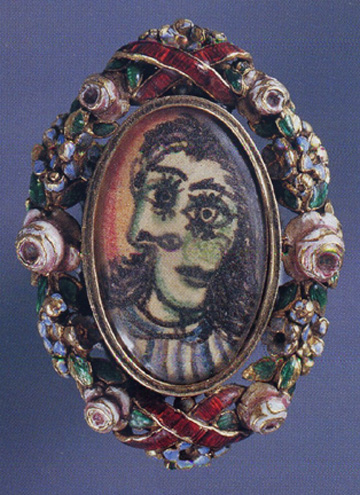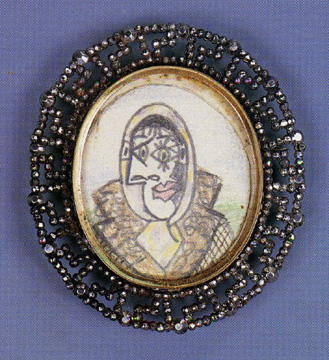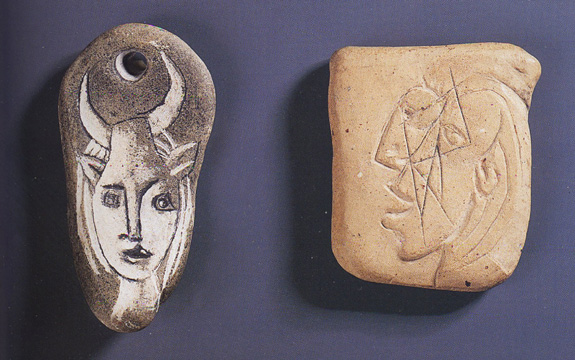Continued from Jewelry by Picasso: the secret stash of Dora Maar, part 1:

At the auction, a chrome-metal watch with a brass plaque engraved with a portrait of Maar sold for about $63,000 – 19 times its estimated value of $3,300. A portrait ring in a metal frame of lattice flower work, estimated at about $16,500, sold for almost $108,000. An oval brooch with a colored pencil portrait of Maar fetched nearly $70,000. Not bad for quick sketches set in existing mounts.
“The sentimental value was what drove the prices up,” said jewelry expert Philippe Serret, who valued the jewelry for auction. He insists the estimates were not low, but that there were no precedents for mementos made by Picasso for a lover.
It was Maar’s face, with her intense dark eyes, regal nose, and rounded chin, that the artist was painting obsessively when he began distorting images, a style now considered his trademark. Her face appeared over and over during his prolific War years, looking increasingly tortured as the romance progressed. “Dora has always been a weeping woman for me,” Picasso would say, according to Pierre Cabanne in Pablo Picasso: His Life and times, 1977.”For years I painted her in tortured forms, not out of sadism or pleasure. . . . It was Dora’s profound reality.”

Most of the jewelry Picasso made for Maar features miniature versions of this distorted portrait, mostly sketched in color pencil and mounted in metal brooches and rings. Picasso did not do any metalwork, merely inserted his drawings into existing jewelry that ranged from gold and enamel to steel with simulated marcasite.
“This was a woman who would not accept conventional jewelry,” says Serret, who cataloged the collection in addition to valuing the jewelry. “These were the only kinds of jewels she would accept.”
It was the more primitive carved amulets that I found most charming. During vacations with Maar along the French Mediterranean, Picasso would collect stones and pottery shards on the beach and engrave images into them with his pocket knife. These engravings were more commonly known among his friends than the miniature framed portraits.
“Ever since the Boisgeloup period, when a new inspiration gave birth to a rich production, he contented himself with making little sculptures, often inspired by lucky finds of bones or pebbles on which he carved classic profiles, heads of horned gods or monsters,” wrote Roland Penrose in Portrait de Picasso, 1956. (“Boisgeloup” was the country estate Picasso bought in 1932, 40 miles from Paris, whose vast grounds and open spaces allowed him to begin seriously exploring sculpture.)

“I make things on the beach,” Picasso told Penrose. “The pebbles are so beautiful that I feel like carving them all . . . and the sea sculpts them so beautifully, gives them such pure and full shapes, that only a little effort is needed for us to make them into works of art. . . . Some of them suggest heads of women or fauns. . . .” And, of course, Picasso considered himself the true authority on the sea’s artistic intentions. Two young boys once brought him a pebble, he said. “They claimed it was the head of a dog until I showed them that in reality it was a typewriter.”
Though a few were actually stone, among the engraved “beach pebbles” in Maar’s stash, most were of terra cotta, some with holes at the top so that she could wear them as amulets. A few were engraved with her portraits or the head of a satyr. Estimated between $1,000 and $8,300, they sold for eight times that on average. A portrait of Maar engraved on a bone amulet sold for $53,000 (estimated at $6,600) and a fawn engraved on terra cotta, estimated at $4,140, brought $34,770….
Continued: Jewelry by Picasso: the secret stash of Dora Maar, part 3
Related posts:
Alexander Calder’s jewelry: going mobile
Salvador Dali: bejeweled surrealism
Related product: (Purchasing through links on this site does not cost you more, but it does put a few pennies toward the continuation of this blog.)
